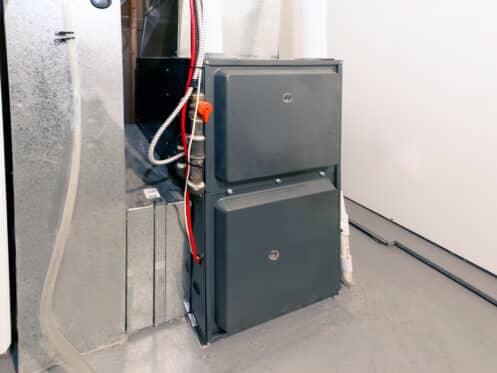Choosing the right size gas furnace for your home matters for several reasons. It not only affects the unit’s ability to heat your home but also your heating bills. The harder it is for the system to heat your home, the higher your energy costs. Fortunately, the easiest way to avoid this problem is to buy the right gas furnace. Let’s explore 12 questions to ask yourself (or a professional) to ensure you choose the right size.
1. How Well Is My Home Insulated?
Your home’s level of insulation greatly matters when selecting the right size gas furnace. Homes with good insulation retain heat more effectively, minimizing stress on the heating system. This is particularly true in homes with well-insulated floors, ceilings and walls. Basing your decision, in part, on your home’s insulation helps ensure you don’t choose a unit that’s too big or too small. Homes with poor insulation will, of course, need a higher-capacity furnace.
2. How Does the Local Climate Affect My Home’s Heating?
Choosing the right size gas furnace for a Washington house requires careful consideration of local climatic trends. This is because temperature is a major factor in heating needs, particularly in colder areas. Furnaces with higher heating capacities work best in regions with extremely cold winters, like Washington. Only homes in the milder coastal parts of the state benefit from furnaces with lower heating capacities.
3. How Many Windows and Doors Does the Home Have?
Choosing the correct size gas furnace also requires careful consideration of the number of windows and doors in the house. One way heat can enter or leave a house is via its doors and windows. The possibility of heat exchange increases as the number of doors and windows in a house increases. To find out how much heat the furnace needs to compensate for any heat losses, it’s important to accurately measure these openings. To maximize energy efficiency and guarantee constant comfort levels, you’ll need to match the furnace with the home’s thermal characteristics.
4. What AFUE Rating Is Best for My Home?
Look at the annual fuel utilization efficiency (AFUE) rating of a gas furnace to choose the appropriate size. An efficient furnace will have a high AFUE because of how well it turns fuel into heat. The higher the rating, the greater the efficiency. Average AFUEs typically vary from 80% to 95% in Washington, a state that places a premium on energy efficiency. Furnaces with higher AFUE ratings improve energy efficiency, save money on utility bills and accommodate the state’s energy-conscious climate.
5. What Is the Local Energy Cost?
Before you buy a gas furnace, it’s important to calculate the cost of energy in your area. Homeowners in areas where energy prices are higher save money on utility bills by upgrading to furnaces that use less energy. Where energy prices are lower, finding the sweet spot between initial investment and return on investment may become more important. In Washington, the average homeowner spends about $80 on natural gas each month.
6. Does the Gas System Need to Provide Cooling?
You can get warmth and cooling from certain gas heating systems, such as gas furnaces with air conditioners. Optimal indoor temperature management is a year-round benefit of these systems. Any homeowner looking to purchase a gas furnace should take their heating and cooling demands into account when making their selection. This heating and cooling system is multipurpose and all-inclusive. However, it’s important to have the right size to get the best performance, energy economy and comfort. A larger gas furnace is not always required to provide cooling; in fact, it is fairly uncommon for smaller gas furnaces to work in tandem with larger HVAC systems. The heating and cooling demands are what ultimately dictate the size of the HVAC system the most.
7. Do I Have Any Remodeling Plans?
Before buying a gas furnace, it’s important to think about any renovations that may be in the works. A home’s heating needs will alter because of changes to the floor plan, square footage or insulation. By planning ahead for these adjustments, you can select a furnace that keeps up with your home’s changing heating demands. This foresight avoids problems like a furnace that isn’t big enough to handle the extra heating needs after renovations. As a result, homeowners save money on furnace replacements and upgrades.
8. How Many Floors Does the Home Have?
Smaller furnaces, usually ranging from 40,000 to 80,000 BTUs, are more suitable for houses with one story. Houses with two stories may need a somewhat bigger furnace—anything from 60,000 to 100,000 BTUs. Furnaces with a capacity of 80,000 to 120,000 BTUs are commonly necessary for three-story residences to distribute heat efficiently throughout all three stories. Properly sizing the furnace to the home’s vertical structure ensures that every level remains consistently heated, leading to maximum performance.
9. How Many People Live in the Home?
Heating a house according to its unique requirements is possible by adjusting the furnace size to the number of residents. Having more people living in the house might mean you need a larger gas furnace to ensure everyone’s comfort.
10. What Condition Is the Ductwork In?
Ducts that are well-kept and airtight increase the heating system’s effectiveness. This guarantees that the furnace efficiently distributes heat. Inefficient or leaking ductwork allows heat to escape, which in turn reduces the efficiency of the furnace. As a result, homes with leaky ductwork need higher-capacity gas furnaces to keep up with heating demands. This is why it’s helpful to invest in ductwork repairs. You can improve your home’s heating efficiency, eliminating the need for a higher-capacity furnace.
11. What Is the Ceiling Height Throughout the Home?
Heating a larger volume of air in a home with higher ceilings uses more energy. This is because greater heat dispersion affects the total heating demand in taller rooms. To get the most out of your gas furnace, it’s crucial to think about this while determining its size. If you have tall ceilings, you may need a higher capacity furnace.
12. What Is the Home’s Square Footage?
Choosing the right size gas furnace requires careful consideration of the home’s square footage. A home’s heating requirements are proportional to its square footage. Inefficiency and discomfort will result from a furnace that is too small for the home’s heating needs. Alternatively, if the home is too small for the furnace, it will waste energy by cycling on and off too often. This causes extreme wear and tear and frequent breakdowns, along with higher energy costs.
Homes with around 1,000 square feet need a gas furnace with a capacity of approximately 40,000 to 60,000 BTUs (British Thermal Units). 2,000-square-foot homes require a capacity of around 60,000 to 80,000 BTUs. Larger homes with 3,500 square feet need even higher capacities, ranging from 80,000 to 100,000 BTUs or more.
Hunt’s Services is here to help you select the right size furnace for your home. We also offer a variety of other services to improve indoor comfort. Some of our most popular services include water filtration installation, bathroom plumbing, sewer and drain cleaning, excavation, electrical panel installations and so many more. Contact us now to learn more about choosing the best gas furnace for your Tacoma, WA, home.




